- Home
- About
- Map
- Trips
- Bringing Boat West
- Migration West
- Solo Motorcycle Ride
- Final Family XC Trip
- Colorado Rockies
- Graduates' XC Trip
- Yosemite & Nevada
- Colorado & Utah
- Best of Utah
- Southern Loop
- Pacific Northwest
- Northern Loop
- Los Angeles to NYC
- East Coast Trips
- Martha's Vineyard
- 1 Week in Quebec
- Southeast Coast
- NH Backpacking
- Martha's Vineyard
- Canadian Maritimes
- Ocracoke Island
- Edisto Island
- First Landing '02
- Hunting Island '02
- Stowe in Winter
- Hunting Island '01
- Lake Placid
- Chesapeake
- Provincetown
- Hunting Island '00
- Acadia in Winter
- Boston Suburbs
- Niagara Falls
- First Landing '99
- Cape Hatteras
- West Coast Trips
- Burning Man
- Utah Off-Roading
- Maui
- Mojave 4WD Course
- Colorado River Rafting
- Bishop & Death Valley
- Kauai
- Yosemite Fall
- Utah Off-Road
- Lost Coast
- Yosemite Valley
- Arizona and New Mexico
- Pescadero & Capitola
- Bishop & Death Valley
- San Diego, Anza Borrego, Joshua Tree
- Carmel
- Death Valley in Fall
- Yosemite in the Fall
- Pacific Northwest
- Utah Off-Roading
- Southern CA Deserts
- Yosemite & Covid
- Lake Powell Covid
- Eastern Sierra & Covid
- Bishop & Death Valley
- Central & SE Oregon
- Mojave Road
- Eastern Sierra
- Trinity Alps
- Tuolumne Meadows
- Lake Powell Boating
- Eastern Sierra
- Yosemite Winter
- Hawaii
- 4WD Eastern Sierra
- 4WD Death Valley +
- Southern CA Deserts
- Christmas in Tahoe
- Yosemite & Pinnacles
- Totality
- Yosemite & Sierra
- Yosemite Christmas
- Yosemite, San Diego
- Yosemite & North CA
- Seattle to Sierra
- Southwest Deserts
- Yosemite & Sierra
- Pacific Northwest
- Yosemite & South CA
- Pacific Northwest
- Northern California
- Southern Alaska
- Vancouver Island
- International Trips
- Index
- Tips
- Books
- Photos/Videos
- Search
- Contact
Venice, Italy
Wednesday, May 31, 2017 - 6:15pm by Lolo
275 miles and 5.5 hours from our last stop - 5 night stay
Travelogue
 Camping Marina di Venezia beach on the Adriatic SeaComing from a country that takes multiple days to cross, it was pretty amazing to us how compact Europe is. Within five hours of leaving the snow-covered Bavarian Alps in Berchtesgaden, we were in Venice -- or at least in a campground on Punto Sabbioni just across the lagoon.
Camping Marina di Venezia beach on the Adriatic SeaComing from a country that takes multiple days to cross, it was pretty amazing to us how compact Europe is. Within five hours of leaving the snow-covered Bavarian Alps in Berchtesgaden, we were in Venice -- or at least in a campground on Punto Sabbioni just across the lagoon.
This was the campground that Herb had been dreaming of ever since he saw the giant aerial photograph of it in the McRent lounge. It’s called Camping Marina di Venezia and it’s the largest campground in Europe.
The facilities are beyond anything I have ever seen in the U.S. There is an Aquamarine Park with 5 pools, including an Olympic size lap pool, a wave pool, 3 large water slides, a play area with a giant tipping bucket that periodically dumps gallons of waters on heads below, and several jacuzzis. There are 3 restaurants, 2 bars; a supermarket, a hair salon (where you can even get your armpits done), all kinds of shops, a doctor’s office, a stage for performances, and on and on. Oh, and did I mention a sandy mile-long beach on the Adriatic Sea?
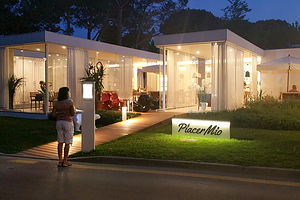 Not your everyday campground restaurantIt was like a closed ecosystem, a city unto itself. You could live there for years and never have to leave.
Not your everyday campground restaurantIt was like a closed ecosystem, a city unto itself. You could live there for years and never have to leave.
I was a bit fearful that Herb was thinking just that. Hopefully, the lure of Venice would be too much for him to resist.
We negotiated a plan that would incorporate some down time into our somewhat frantic schedule. We agreed to spend five nights in this incredible campground in order to allow us four full days here. On the first full day (tomorrow) we would just hang out at the campground, enjoying the pools and swimming in the Adriatic Sea from the campground beach. On days 2 and 3 we would play tourists and visit Venice and the outer islands (Murano, Torcello, and Burano). Then on day 4 we would relax at the campground once again, culminating with a fireworks display on the beach that night. It seemed like they scheduled it just for us.
Day 1 - Camping Marina di Venezia lap pool, first “shushy time”, and beach on the Adriatic Sea
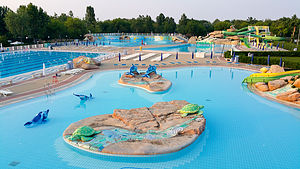 Camping Marina di Venezia Aquamarina ParkWe learned two surprising things today. First, Germans really really like to camp. Although we were in Italy, 90% of the people camping here were Germans. After that probably about 5% were from the Netherlands. Except for the employees, there wasn’t an Italian in sight.
Camping Marina di Venezia Aquamarina ParkWe learned two surprising things today. First, Germans really really like to camp. Although we were in Italy, 90% of the people camping here were Germans. After that probably about 5% were from the Netherlands. Except for the employees, there wasn’t an Italian in sight.
Second, Spain does not have a monopoly on siestas. Germany, Italy, and Switzerland seem to love their mid-day nappy time too. Maybe we didn’t notice it at our previous stops, because we were out during the day, but between noon and 2:00 each day (and even as long as between 11:00 am and 3:00 pm in other places we would visit), everything comes to a stop - supermarkets, campground offices, and shops close; German people disappear into their campers or loungers to nap; and a hush falls over the campground, as everyone is encouraged to enjoy some quiet downtime.
I was too hyper for this, but Herb thought it was great. He called it “Shushy Time.”
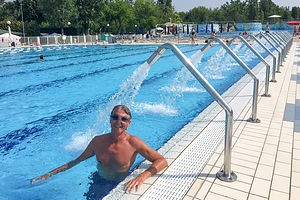 Herb enjoying Camping Marina di Venezia Aquamarina ParkWe spent pre-shushy time at the Aquamarina Park. This place truly is incredible. Herb loves to swim for exercise, and when we are home, he goes at least 3 or 4 days a week to our community pool to swim laps. He was in heaven at the thought of being able to do that here. I figured I would join in as well, although I am not the best of swimmers in that I hate putting my face underwater without holding my nose. At home, I use goggles and a snorkel, but here I was on my own.
Herb enjoying Camping Marina di Venezia Aquamarina ParkWe spent pre-shushy time at the Aquamarina Park. This place truly is incredible. Herb loves to swim for exercise, and when we are home, he goes at least 3 or 4 days a week to our community pool to swim laps. He was in heaven at the thought of being able to do that here. I figured I would join in as well, although I am not the best of swimmers in that I hate putting my face underwater without holding my nose. At home, I use goggles and a snorkel, but here I was on my own.
I felt pretty at home here though, because I think European woman often swim with their heads above water as well. Herb’s mom, who was from Germany, used to do this, but I always thought it was to keep her perfectly coiffed hair in tact. For whatever reason, there were plenty of women doing this here as well.
 Lolo frolicking in the Adriatic SeaWe set off in the pool with the intention of swimming a mile, which is 32 lengths of an Olympic pool. About half way through our workout, Herb’s lane turned into an aqua aerobics class, and he soon found himself surrounded by dozens of elderly bobbing German women, bouncing up and down while moving their arms in sync to the loud dance music coming from the large speakers that had been placed at the end of the pool. He looked confused. I found it hilarious.
Lolo frolicking in the Adriatic SeaWe set off in the pool with the intention of swimming a mile, which is 32 lengths of an Olympic pool. About half way through our workout, Herb’s lane turned into an aqua aerobics class, and he soon found himself surrounded by dozens of elderly bobbing German women, bouncing up and down while moving their arms in sync to the loud dance music coming from the large speakers that had been placed at the end of the pool. He looked confused. I found it hilarious.
So, we cut our workout short and headed back to the campsite to enjoy our first “shushy time.” I have to admit, it is kind of nice to just chill for awhile in the afternoon.
Afterwards, we walked the short distance to the beach to spend the remainder of the afternoon sunning on the sandy beach and periodically dipping in and out of the luxuriously warm water. It was quite lovely.
Day 2 - Venice
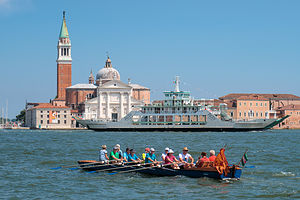 St. Mark's Square from or Vaporetto ride along the Grand CanalDescribing Venice in words is beyond my skills as a writer. Besides, I don’t think there is anyone that doesn’t have a pretty vivid image in their mind of the uniqueness and beauty of this incredible old city.
St. Mark's Square from or Vaporetto ride along the Grand CanalDescribing Venice in words is beyond my skills as a writer. Besides, I don’t think there is anyone that doesn’t have a pretty vivid image in their mind of the uniqueness and beauty of this incredible old city.
Since Venice is an island without roads, getting to and around it requires some form of water transport. There are basically three types: gondola (romantic, pricey, and great for selfies), water taxi (less romantic, less pricey, but convenient), and vaporetto (most economical).
For our needs, the vaporetto made the most sense. It is Venice’s public transit system and works like city buses with established schedules and fares. Single ride tickets are 7.50 euros, which can really add up, one-day Travel Passes are 20 euros, and the two-day Travel Pass is 30.
We decided on the two-day Travel Pass, which would allow us to take unlimited rides over a 48-hour period. It would pay for itself in just 4 rides. Plus, we wanted the freedom to feel we could just hop on and off the ferry as we pleased.
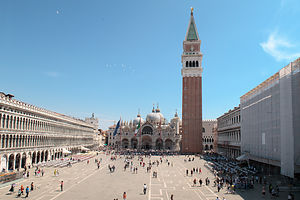 St. Mark's SquareThe Punto Sabbioni vaporetto dock was a 2-mile walk from the campground. There is a bus that runs between the campground and the dock, but rather than wait for it, we decided to just walk. At the dock we purchased our Travel Passes, and the 48 hour clock started ticking as soon as we validated them to board the boat.
St. Mark's SquareThe Punto Sabbioni vaporetto dock was a 2-mile walk from the campground. There is a bus that runs between the campground and the dock, but rather than wait for it, we decided to just walk. At the dock we purchased our Travel Passes, and the 48 hour clock started ticking as soon as we validated them to board the boat.
It was a 30-minute boat ride, including one stop on the island of Lido, to the San Marco dock. From there it was just a brief walk to the famous Piazza San Marco (St. Mark’s Square), Venice’s religious and political center for centuries.
I’m glad we got an early start this morning, because the Piazza was still fairly quiet, allowing us to have it almost to ourselves to enjoy with the pigeons, before the inevitable stream of tourists began pouring in.
The Square is quite large - almost two football fields long -- and lined by a colonnaded arcade, which houses dozens of shops, restaurants, and cafes, many of which were getting ready for the day, setting up tables and chairs in the Piazza in anticipation of the crowds to come.
Four major historical buildings surround the Square: St. Mark’s Basilica, the Doge’s Palace, the Campanile bell tower, and the Correr Museum.
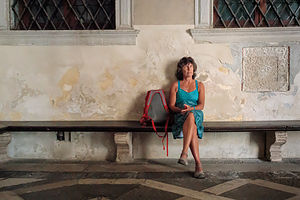 Lolo of the Doge's PalaceWe decided to visit the Doge’s Palace first. Before leaving the campground this morning, we had purchased a museum combo pass that gave us admission to the Doge’s Palace as well as a few others we planned to visit, such as the Correr Museum and the Glass Museum on Murano island. Depending on what you want to visit, there are lots of different museum passes to choose from: http://www.venice-museum.com/venice-museum-pass
Lolo of the Doge's PalaceWe decided to visit the Doge’s Palace first. Before leaving the campground this morning, we had purchased a museum combo pass that gave us admission to the Doge’s Palace as well as a few others we planned to visit, such as the Correr Museum and the Glass Museum on Murano island. Depending on what you want to visit, there are lots of different museum passes to choose from: http://www.venice-museum.com/venice-museum-pass
The Doge’s Palace, which was built in the 14th century, was once the official residence of Venice’s doges (dukes) and the seat of the Republic’s government. Unlike other European palaces of the time, it was less a fortress than an in-your-face display of wealth and power, which can be even more effective at keeping your enemies at bay.
Rather than being heavy and impenetrable, it is light and open, full of windows and pointed arcades, with lavish moldings and decorative quatrefoils. The upper story, which rests on a double arcade of slender marble columns, is ornamented with lacy patterns of pink Verona marble. It is a masterpiece of Venetian Gothic architecture that should be on every traveler’s bucket list.
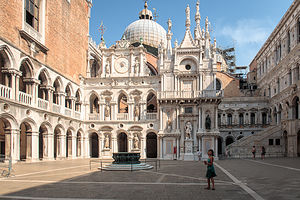 Courtyard of the Doge's PalaceThe interior of the Palace was even more incredible. We entered the Palace through the Foscari Arch, which was decorated with alternate bands of white stone and red marble, and found ourselves in a large central courtyard, ornamented with columns, niches, and turrets. On the far end of the courtyard, is the Scala dei Giganti, or Staircase of the Giants, which leads up to the State Apartments on the upper floor. The top of the stairs is flanked by two colossal statues of Mars and Neptune to represent Venice’s power by land and by sea.
Courtyard of the Doge's PalaceThe interior of the Palace was even more incredible. We entered the Palace through the Foscari Arch, which was decorated with alternate bands of white stone and red marble, and found ourselves in a large central courtyard, ornamented with columns, niches, and turrets. On the far end of the courtyard, is the Scala dei Giganti, or Staircase of the Giants, which leads up to the State Apartments on the upper floor. The top of the stairs is flanked by two colossal statues of Mars and Neptune to represent Venice’s power by land and by sea.
We, however, began our self-guided tour by ascending another grand staircase called the Scala d’Oro, or Stairs of Gold, to the Doge’s apartment on the first floor (which is actually the second floor in Europe, with the ground floor being the first). The apartment has no furnishings, because they were partly stolen by Napolean’s army, but there are some masterpieces painted on the ceilings, which gave us an idea of its past opulence.
The staircase continued up to the incredibly lavish government offices on the second floor. Rather than just wandering aimlessly from room to room, signs directed us sequentially from one room to the next. This way I didn’t have to worry about missing one, which I usually obsess over when left to my own devices.
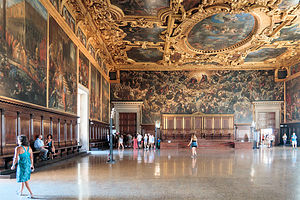 Sala del Maggiore Consiglio in the Doge's PalaceThe most breathtaking and over-the-top room was the Sala del Maggiore Consiglio, or Hall of the Grand Council. The room was huge, 175 feet by 80 feet, and the place where up to 2,000 members of the aristocracy met to discuss the business of the Republic. In this room, all the Republic’s power and glory were on display and meant to impress, not only for its immense size, but also for the inestimable value of its wall and ceiling decorations.
Sala del Maggiore Consiglio in the Doge's PalaceThe most breathtaking and over-the-top room was the Sala del Maggiore Consiglio, or Hall of the Grand Council. The room was huge, 175 feet by 80 feet, and the place where up to 2,000 members of the aristocracy met to discuss the business of the Republic. In this room, all the Republic’s power and glory were on display and meant to impress, not only for its immense size, but also for the inestimable value of its wall and ceiling decorations.
The paintings on the walls in the Hall were originally done by artists such as Bellini and Titian. However, a fire in 1577 destroyed their work, and Tintoretto and Veronese were commissioned to paint this room as well as the other rooms damaged by the fire.
Tintoretto chose to go big and paint a massive 72 by 23-foot painting of Jesus Christ and Mary in heaven surrounded by 500 saints on the wall over the Doge’s throne. Called “Paradise”, it is the largest oil painting in the world. Being in that room was a very poignant and humbling and experience.
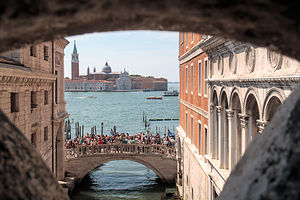 Prisoner's Eye View from the Bridge of SighsBesides being the Doge’s residence and the seat of the Republic’s government, the Doge Palace also housed a prison, linked to the Palace by the infamous Bridge of Sighs. Built in 1614, the bridge and the New Prisons were meant to be an upgrade from the bleak, inhospitable original prison on the ground floor of the Palace.
Prisoner's Eye View from the Bridge of SighsBesides being the Doge’s residence and the seat of the Republic’s government, the Doge Palace also housed a prison, linked to the Palace by the infamous Bridge of Sighs. Built in 1614, the bridge and the New Prisons were meant to be an upgrade from the bleak, inhospitable original prison on the ground floor of the Palace.
Unlike the other bridges in Venice, the Bridge of Sighs is totally enclosed and covered on all sides, to prevent any possibility of escape, with a few small windows with stone bars. As we walked across the bridge, I, as thousands of tourists before me, tried to imagine myself as a prisoner, looking out at their beloved city of Venice for possibly the last time. I let out a sigh, and continued on into the prisons. If the New Prison was meant to be an improvement in conditions, I would hate to see what the old one was like.
From opulence, wealth, and power to despair and hopelessness, our incredible tour of the Doge’s Palace had taken us on a fascinating journey through the extreme ends of Venetian society, the most fortunate and the least, with no stops in the middle.
Although Herb and I are history buffs -- just ask me a question about the American Revolution -- we are admittedly weak, despite our attempts at preparation, in Italian history. The Museo Correr, on the opposite side of St. Mark’s Square from the Basilica, was the perfect place to correct that.
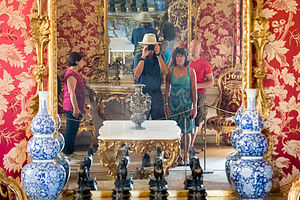 Correr MuseumThe Museo Correr originated in 1830, when Teodoro Correr, a passionate collector of everything Venice, bequeathed to the city his entire collection of art, documents, and objects charting the history of Venice from the Medieval 13th century up until his death.
Correr MuseumThe Museo Correr originated in 1830, when Teodoro Correr, a passionate collector of everything Venice, bequeathed to the city his entire collection of art, documents, and objects charting the history of Venice from the Medieval 13th century up until his death.
Wandering its rooms is like taking a journey through Italian history, art, and culture. The museum is laid out in several sections. The Napoleonic Wing, which was originally a 19th century palace, houses a remarkable collection of works by the great late 18th, early 19th century, sculptor Antonio Canova.
The next set of rooms, the Procuratie Nuove designed by Vincenzo Scamozzi in the 16th century, contains collections documenting Venetian history - from military battles, politics, to daily life.
Beyond these rooms is the Art Collection from the earliest days of Venetian painting to the 16th century, with works by artists such as Bellini, Messina, and Carpaccio.
 Correr Museum - closeup of Farsi calligraphy on “The Home of My Eyes” exhibitThere are also special exhibits with contemporary prints, photographs, and paintings. One which we found particularly interesting was “The Home of My Eyes” by Shirin Neshat. The work consisted of 55 close-up, photographic portraits of diverse people from Azerbaijan, each staged in similar clothing and posed against a dark background. Across their faces is Farsi calligraphy, so small that we only noticed it when we stood up close. The writing is text composed by Neshat from both the sitters’ responses to the notion of homeland and from poems by a 12th century Iranian poet, who lived in what is present-day Azerbaijan.
Correr Museum - closeup of Farsi calligraphy on “The Home of My Eyes” exhibitThere are also special exhibits with contemporary prints, photographs, and paintings. One which we found particularly interesting was “The Home of My Eyes” by Shirin Neshat. The work consisted of 55 close-up, photographic portraits of diverse people from Azerbaijan, each staged in similar clothing and posed against a dark background. Across their faces is Farsi calligraphy, so small that we only noticed it when we stood up close. The writing is text composed by Neshat from both the sitters’ responses to the notion of homeland and from poems by a 12th century Iranian poet, who lived in what is present-day Azerbaijan.
From the windows on the upper floor of the museum, we had a tremendous view of the entire Piazza San Marco. I think this has to be the best view of the Square you can get, because from its location on the west end of the Piazza, you get to see all the good stuff on the east end - St. Mark’s Basilica, The Campanile, and the Doge’s Palace, all in one visual sweep.
From here, we could see that the line to enter the Basilica was already huge. Rather than join it, we stopped in a tour ticket office near the museum, and purchased "skip the line" tickets for 2 euro each. If your willing to wait on line, admission is free.
A little background first about this amazing church whose ornate domes, intricate arches and spires, lavish marble work, and gold mosaics dominate the east end of the square. I had seen enough of Venice already to understand that they liked to show off their wealth and power, so it was no surprise that St. Mark’s Basilica was the largest and most lavishly decorated church of its time.
This was not the first church to be built on this site. The original 9th-century basilica was built to house the remains of St. Mark, the patron saint of Venice. It burnt down in 932, and the construction of the present-day church began in 1063, just nine years after the schism between the Western (Catholic) and Eastern (Orthodox) churches.
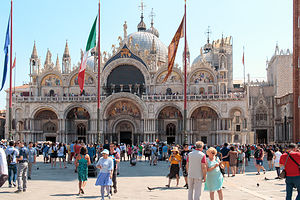 St. Mark's BasilicaIts architectural style very much reflects its ties to the Byzantine Empire, which had ruled Venice for many centuries. Unlike the rectangular structure of Western basilicas, it has a Greek-cross plan, with each cross having its own dome - plus one more in the center, making five in total.
St. Mark's BasilicaIts architectural style very much reflects its ties to the Byzantine Empire, which had ruled Venice for many centuries. Unlike the rectangular structure of Western basilicas, it has a Greek-cross plan, with each cross having its own dome - plus one more in the center, making five in total.
Before entering the church, we had to check our backpacks at the nearby Ateneo San Basso church, just 30 yards to the left of the basilica. Checking was free for up to one hour. Only afterwards did I learn that checking a bag automatically gives you "skip the line" privileges. Oh well.
Catholic churches do not like bare shoulders, so I had to purchase a plastic, orange shapeless sheet to cover them for 1 euro. I didn’t realized that bare knees was an issue as well. Fortunately, my dress was long enough to cover mine, but some poor woman had to buy two sheets and wrap herself up like a mummy. Finally, sans backpack, but with mini-tarp, we were ready to enter the church.
The interior of the church is as spectacular as its exterior, but unfortunately photography is not allowed. Its spacious interior, covered with over 40,000 square feet of gold mosaics, was another example of Venice flexing its muscles and letting the world know that this was a wealthy and powerful city. To ensure that continued, in 1075 the Doge passed a law requiring that all returning ships bring something precious back to decorate the basilica.
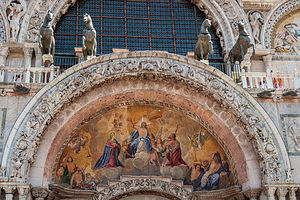 Tympanum over St. Mark's Basilica entranceWe were herded a little bit like cattle along one aisle up towards the altar and then across and back down the other side. Although we were restricted from straying from the aisle, the views of the mosaics, columns, altar, etc. were pretty amazing. Along the way, there were several roped-off sections that required an extra fee to visit, such as the Pala d’Oro (Altarpiece of Gold), beneath which St. Mark is interred.
Tympanum over St. Mark's Basilica entranceWe were herded a little bit like cattle along one aisle up towards the altar and then across and back down the other side. Although we were restricted from straying from the aisle, the views of the mosaics, columns, altar, etc. were pretty amazing. Along the way, there were several roped-off sections that required an extra fee to visit, such as the Pala d’Oro (Altarpiece of Gold), beneath which St. Mark is interred.
After we got outside again, I noticed people looking down on the Square from a balcony that ran the length of the church above the door and arches. How did they get up there, and why hadn’t we? I only learned afterwards that there is a staircase, just inside the front doors of the church, that leads up to this balcony, known as the Galleria. It costs extra, of course, but who cares. It looked phenomenal. I was so mad that I almost- but not quite - wanted to get in line again.
We retrieved our backpacks within our allotted hour and set off to explore the back alleyways of Venice, hoping to leave some of the crowds that now filled the Square behind. We had no idea where we were going, but it was an island after all, so we couldn’t get too lost, at least for long. It was so much fun zigging and zagging through the pedestrian alleyways. I especially enjoyed strolling through the quieter, less touristy sections where Venetians actually live.
 Gondola on the Grand CanalOur route wasn’t totally random though, as I had an objective in mind - to end our ramble at the far end of the Grand Canal by Piazzale Roma and then cruise the Grand Canal via vaporetto all the way back to San Marco, under its bridges and past its palaces.
Gondola on the Grand CanalOur route wasn’t totally random though, as I had an objective in mind - to end our ramble at the far end of the Grand Canal by Piazzale Roma and then cruise the Grand Canal via vaporetto all the way back to San Marco, under its bridges and past its palaces.
Equally attention getting to the sights alongside the canal was the controlled chaos of the boat traffic in the canal - gondolas, water taxis, vaporettos, kayaks, rowing skulls - all zigging and zagging within inches of each other. I kept expecting a collision at any moment, but these people were professionals and dealt with it day after day.
From San Marco, we took the vaporetto back to Punta Sabbioni and walked the two miles back to the campground.
What a magical day it had been!
Day 3 - Venetian outer islands (Murano, Torcello, and Burano)
 The colors of BuranoToday we would continue our tour of Venice and visit three of its outer islands - Murano, Torcello, and Burano.
The colors of BuranoToday we would continue our tour of Venice and visit three of its outer islands - Murano, Torcello, and Burano.
As we did yesterday morning, we walked the two miles to the Punto Sabbioni vaporetto dock, but this time we took the #12 line to the outer islands rather than the one to San Marco.
As we approached the first island, Burano, we got a glimpse of the famous brightly-colored fishermen’s houses we had read about. They were so picturesque that we were tempted to get off, but we stuck to our original plan of going to the island furthest out first, Murano, and then working our way back.
We stayed on through the Torcello stop as well, and got off at Murano. It had taken us about 50 minutes from Punta Sabbioni.
 MuranoMurano is famous for its glassware shops and factories, having been the center of a thriving glasswork industry since 1291, when all the glass artisans in Venice were forced to move to the island because of the risk of fires in crowded Venice. Wow, so Venice was even crowded back then.
MuranoMurano is famous for its glassware shops and factories, having been the center of a thriving glasswork industry since 1291, when all the glass artisans in Venice were forced to move to the island because of the risk of fires in crowded Venice. Wow, so Venice was even crowded back then.
When we got off the vaporetto, we headed in the direction of the Murano Glass Museum to learn about the history of glassmaking and see samples of works created over the centuries. Murano is made up of seven islands (Venice was only two), so we found ourselves constantly crossing bridges over canals -- I think sometimes even more than once. As we had learned during our meandering through the pedestrian alleys of Venice, it is not always that easy here to get from point A to B, even with a GPS.
Everywhere we looked there were shops selling glasswork - beads, jewelry, vases, bowls, figurines, you name it. There were also several factories open to the public where you could step in and watch glass blowers performing their craft.
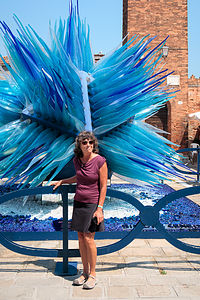 Lolo and her glass headdressFinally, we saw a large, brilliant blue glass starburst sculpture in the middle of a square in front of an old clock tower. Herb took my picture in front of it, posed in such a way that it looked like I was wearing a giant headdress.
Lolo and her glass headdressFinally, we saw a large, brilliant blue glass starburst sculpture in the middle of a square in front of an old clock tower. Herb took my picture in front of it, posed in such a way that it looked like I was wearing a giant headdress.
The museum itself is located in an old Gothic style palace in the Palazzo Giustinian, which was once the residence of the bishops of nearby Torcello island. It opened as a museum in 1861.
Wandering through its rooms, we were treated to a century-by-century tour of Venetian glassmaking, with displays showing how the art and manufacture of glass has developed and changed over time. There were lovely samples of works from Egyptian times through the present day.
We had to pick up the pace a bit, as we wanted to explore all three islands, so we headed back to the vaporetto dock. As we approached, we noticed a huge line of people and wondered what was going on. To our dismay, we learned that this was the line for the vaporetto, and from the size of it, we realized we weren’t getting off this island anytime soon.
After close to an hour and a half, we finally boarded a vaporetto back towards Torcello and Burano. We were so disgusted at the thought of spending over an hour to get off each of the next two islands that we decided to bag it and just go back to Punta Sabbioni. I tried not to be too overly disappointed, but I kept picturing those colorful fishermen’s houses on Burano in the evening light.
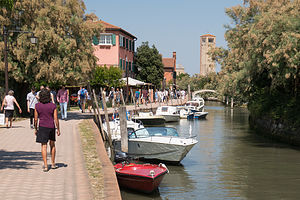 Torcello CanalWhen the vaporetto stopped at Torcello, there were only a few people on the dock to board. Hmm...Maybe this wouldn’t be so bad. We quickly hopped off the boat.
Torcello CanalWhen the vaporetto stopped at Torcello, there were only a few people on the dock to board. Hmm...Maybe this wouldn’t be so bad. We quickly hopped off the boat.
The island was small and most importantly, not crowded. As we walked along the canal leading from the boat dock, we stopped at an outdoor restaurant to have a beer. We were practically glowing from the realization that our day had been brought back from the depths of despair - well, perhaps that is a bit overly dramatic. Let’s just say we were very happy to be here.
It was hard to believe that this island was once the most populated of all the islands in the Venetian lagoon. Settled in 453 (the earliest settlement on the Venetian islands), it even had a cathedral long before Saint Mark’s was even a glimmer in an architect’s mind.
During its heyday, some estimates say that as many as 20,000 people lived here. However, malaria, the arrival of the plague, and the gradual silting up of Torcello’s canals pretty much destroyed their flourishing economy, forcing its inhabitants to flee to the city of Venice.
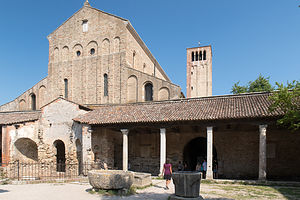 7th century Cathedral of Santa Maria AssuntaToday, Torcello is mostly farmland and has barely 100 residents. However, visitors still flock to the island to see the beautiful old 7th century Cathedral of Santa Maria Assunta and the 12th century Church of Santa Fosca, located next to each other in a grassy square.
7th century Cathedral of Santa Maria AssuntaToday, Torcello is mostly farmland and has barely 100 residents. However, visitors still flock to the island to see the beautiful old 7th century Cathedral of Santa Maria Assunta and the 12th century Church of Santa Fosca, located next to each other in a grassy square.
We only went into the Cathedral of Santa Maria Assunta. If I remember correctly, the entrance fee for the church (plus audio guide) and the campanile was about 9 euro. Unfortunately, photography is not allowed.
Although the church dates back to the 7th century, most of what you see today was rebuilt in the 11th and 12th century in the Byzantine style. The exterior brick facade of the Cathedral is quite plain, and the interior is quite austere as well, especially when compared to St. Mark’s. However, what it does share with St. Mark’s are its golden, Byzantine-style mosaics.
The two most famous mosaics in the Cathedral are the “Madonna and Child” in the apse and the “Last Judgment” on the west wall. I highly recommend the audio guide, which gives a very detailed description of the mosaics. We would have missed so much without it.
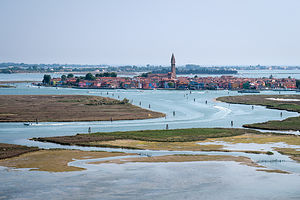 View of Burano from Santa Maria Assunta CampanileI know enough about Christian art during this time period to expect that a depiction of the Last Judgment would be either the first or the last image parishioners would see when attending mass -- a not so subtle reminder that they should behave.
View of Burano from Santa Maria Assunta CampanileI know enough about Christian art during this time period to expect that a depiction of the Last Judgment would be either the first or the last image parishioners would see when attending mass -- a not so subtle reminder that they should behave.
The "Last Judgment" mosaic was huge and occupied the entire counter facade of the church. We probably spent a good half hour pouring over its many details, thanks to our audio guide - the weighing and judgment of the souls, the separation of the blessed from the damned, lots of writhing and suffering on the damned side, etc. I can see how these images left a lasting impression on people as they departed the church.
Afterwards, we climbed the bell tower behind the church for a spectacular view of Torcello, the Venetian lagoon, and the islands.
With more time, we would have visited the 12th century Church of Santa Fosca as well, but we were pretty anxious to get to Burano. Fortunately, there was no Murano-sized line at the dock.
 Burano Lace ShopBurano is to lace, what Murano is to glass, so like Murano, it has countless shops selling everything from tablecloths to doilies to baby booties and wedding gowns; and a museum focused on the history of lacemaking on the island.
Burano Lace ShopBurano is to lace, what Murano is to glass, so like Murano, it has countless shops selling everything from tablecloths to doilies to baby booties and wedding gowns; and a museum focused on the history of lacemaking on the island.
The women of Burano have been stitching lace since the 16th century. Back then the work was extremely exacting. Each woman would specialize in a single stitch (there are seven in total), so completing a piece was a group project passed from one woman to the next. It is extremely time consuming and expensive to make handmade lace, so most of what is being sold in the shops today is made by machine.
However, you can still see samples of handmade lace and even watch how it’s done in some of the shops as well as in the Scuola del Merlotto (Lace Museum) on Burano’s main piazza.
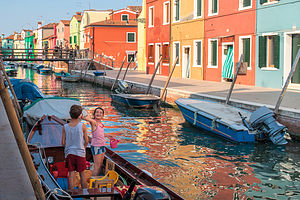 Don't mess with that Burano girlUnfortunately, by the time we got to Burano, the museum was closed. Herb tried to pretend he was disappointed, but I knew he would much rather be photographing the beautiful colors of Burano than learning how a doily is made.
Don't mess with that Burano girlUnfortunately, by the time we got to Burano, the museum was closed. Herb tried to pretend he was disappointed, but I knew he would much rather be photographing the beautiful colors of Burano than learning how a doily is made.
So we spent the next few hours wandering along its canals and through its quaint pedestrian alleys. It was like Venice without the crowds, and felt a lot less touristy and more real. It was, after all, still an active fishing village.
We watched fishing boats coming in at the end of the day with their catch, women hanging their laundry out their windows for all to see, old men sitting on the stoops of their homes watching tourists stroll by, children laughing and playing in the alleys and boats along the canal -- it was pretty enchanting.
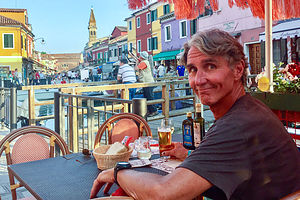 Dinner at Ristorante Pizzeria Principe on BuranoTo us, the brightly colored houses were the real draw of this island. Each house in a row is painted a distinct color. The colors are not random nor even decided by the owner, but rather they follow a specific system that originated back when the island was first developed. The government controls what colors are allowed for each lot. Two houses next to each other are never allowed to be painted the same color. This helps designate where one family’s quarters ends and a neighbor’s begins, as well as makes them visible from the sea.
Dinner at Ristorante Pizzeria Principe on BuranoTo us, the brightly colored houses were the real draw of this island. Each house in a row is painted a distinct color. The colors are not random nor even decided by the owner, but rather they follow a specific system that originated back when the island was first developed. The government controls what colors are allowed for each lot. Two houses next to each other are never allowed to be painted the same color. This helps designate where one family’s quarters ends and a neighbor’s begins, as well as makes them visible from the sea.
We had a nice dinner of pizza and wine at the Ristorante Pizzeria Principe, right alongside a canal, with the Church of San Martino’s leaning campanile in the background.
Let’s just say that on a scale of 1 to 10, today had been an 11.
Day 4 - More campground fun and fireworks over the Adriatic
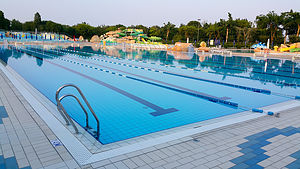 Camping Marina di Venezia Olympic PoolThe last two days had been a whirlwind of activity, so as I had promised Herb, today would be a down day, where we wouldn’t leave the campground - not exactly a hardship as everything anyone could possibly need was there.
Camping Marina di Venezia Olympic PoolThe last two days had been a whirlwind of activity, so as I had promised Herb, today would be a down day, where we wouldn’t leave the campground - not exactly a hardship as everything anyone could possibly need was there.
We spent the morning swimming laps in the Olympic pool, this time timing it not to swim amongst the aqua aerobics. After 32 lengths (1600m), we were ready for Herb’s favorite new European tradition -- siesta (“shushy”) time.
Then it was a lovely afternoon swimming in the Adriatic Sea from the campground beach, followed by pizza at one of the campground restaurants.
What a place!
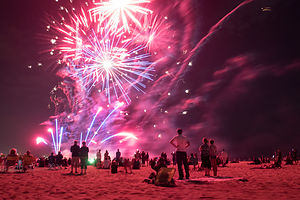 Fireworks at Camping Marina di VeneziaThat evening, the campground put on a fireworks display on the beach that had to be one of the best shows I have ever seen. Italians certainly do know how to do fireworks!
Fireworks at Camping Marina di VeneziaThat evening, the campground put on a fireworks display on the beach that had to be one of the best shows I have ever seen. Italians certainly do know how to do fireworks!
I thought they would be shot off from a barge over the water, like we were used to in the States, but instead they were set off right from the beach. They felt so close that I found myself putting up my hands to protect myself from them falling on me. They didn’t of course - these people were professionals.
It was an appropriately spectacular end to what had been a magical time in Venice.
Description
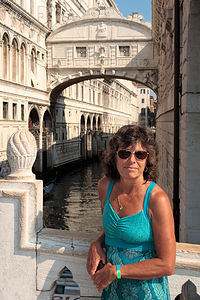 Lolo and the Bridge of SighsWhile I will not attempt to do an in-depth description of all Venice has to offer -- there are numerous guidebooks to do just that -- the following is a list of interesting sites that we enjoyed:
Lolo and the Bridge of SighsWhile I will not attempt to do an in-depth description of all Venice has to offer -- there are numerous guidebooks to do just that -- the following is a list of interesting sites that we enjoyed:
Piazza San Marco (St. Mark’s Square)
This beautiful Square is the heart and soul of Venice. Nearly two football fields long, it is lined by a colonnaded arcade, which houses dozens of shops, restaurants, and cafes. Four major historical buildings surround the Square:
- St. Mark’s Basilica - Venice’s signature church, built in the 11th century to replace the original chapel which was destroyed by fire in 932. Its architecture - exterior domes, arches, and spangled spires; gold mosaics covering both the exterior and interior space, and lavish colored marble - illustrates Venice’s strong connection with Byzantium. Admission to the church is free, but you can pay a small fee to jump the long lines.
- Campanile - bell tower in front of St. Mark’s Basilica. An elevator takes visitors 325 feet to the top for the best views of Venice.
- Doge’s Palace - built in the 14th century, this building served as the official residence of the doges (dukes) and the seat of the Republic’s government for four centuries. A masterpiece of Venetian Gothic architecture, it was built to show off the power and wealth of the Republic. The palace walls are covered with masterpieces by Tintoretto and Veronese. A one-way tour takes visitors through the doges’ apartments on the first floor, up a grand staircase to the incredibly lavish government offices on the 2nd, and finishes with the Bridge of Sighs and the prison.
- Correr Museum - small museum on the west side of the Piazza that has a large collection of art, documents, and objects charting the history and culture of Venice from the Medieval 13th century through the 19th.
Outer Islands
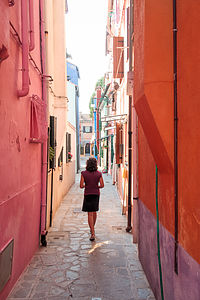 Strolling the alleys of BuranoIn total there are over a hundred of islands in the Venetian Lagoon. The most popular ones to visit, besides the main one of course, are Murano, Burano, and Torcello:
Strolling the alleys of BuranoIn total there are over a hundred of islands in the Venetian Lagoon. The most popular ones to visit, besides the main one of course, are Murano, Burano, and Torcello:
- Murano
Island about a mile north of Venice that is famous for its glassware shops and factories. The island has been the center of a thriving glasswork industry since 1291, when the risk of fires in crowded Venice forced glass artisans to move to Murano. The main attraction on the island is, of course, glass, with countless shops selling Murano glass beads and souvenirs, factories to watch master glass makers performing their craft, and the Murano Glass Museum in the Palazzo Guistinian to learn about the history of glass making. - Torcello
First settled in 452, Torcello was the earliest center of civilization in the Venetian lagoon and had its own cathedral long before Saint Mark’s was built. Once the most populated of all the islands, with estimates as high as 20,000 people, today it is a quiet place with only about 10 permanent residents. Visitors do come, however, to visit the beautiful 7th century Cathedral of Santa Maria Assunta and the 12th century Church of Santa Fosca. - Burano
Island known for its fine, handmade lace and picturesque, pastel-colored fishermen’s houses. The main attraction on this island are related to lace: numerous shops to purchase handmade lace items and the Museum and School of Lace Making to learn about its history. Visitors should also spend an hour or two wandering along its canals and through its pedestrian alleys, photographing the brightly colored houses, especially in evening light.
For information on ticket options for visiting museums in Venice and on the outer islands, see: http://www.venice-museum.com/venice-museum-pass
- ‹ previous
- 7 of 17
- next ›
Venice location map in "high definition"
Javascript is required to view this map.
